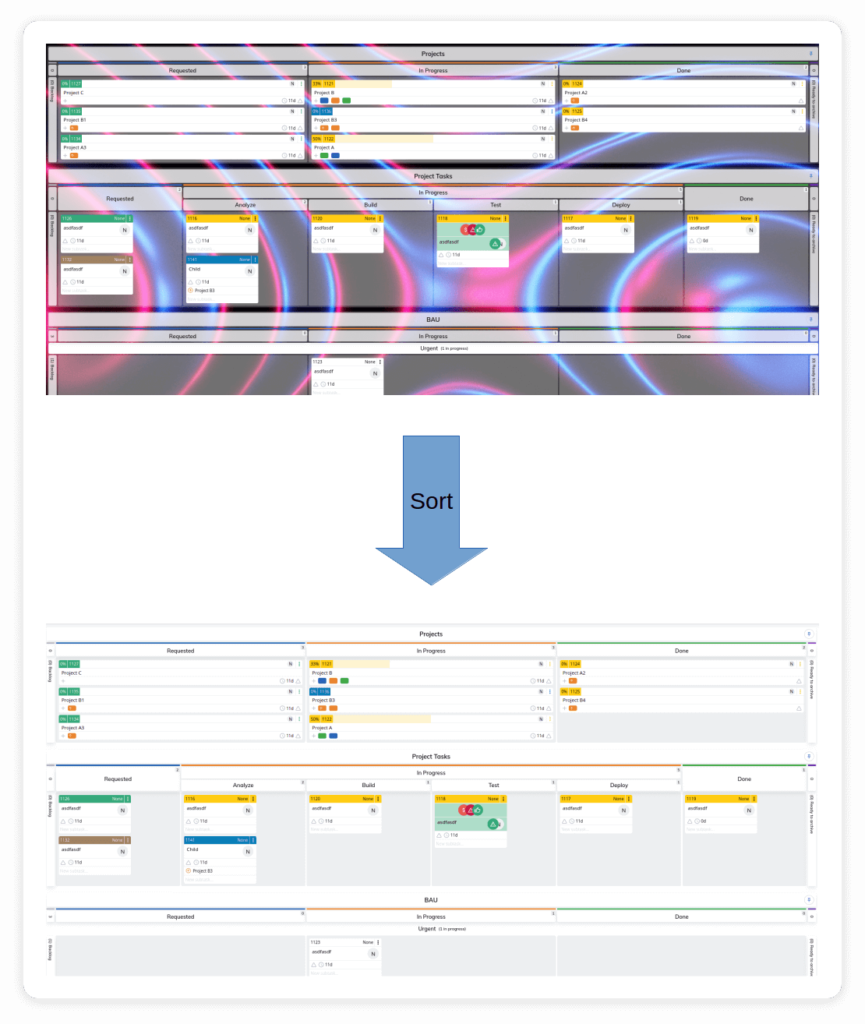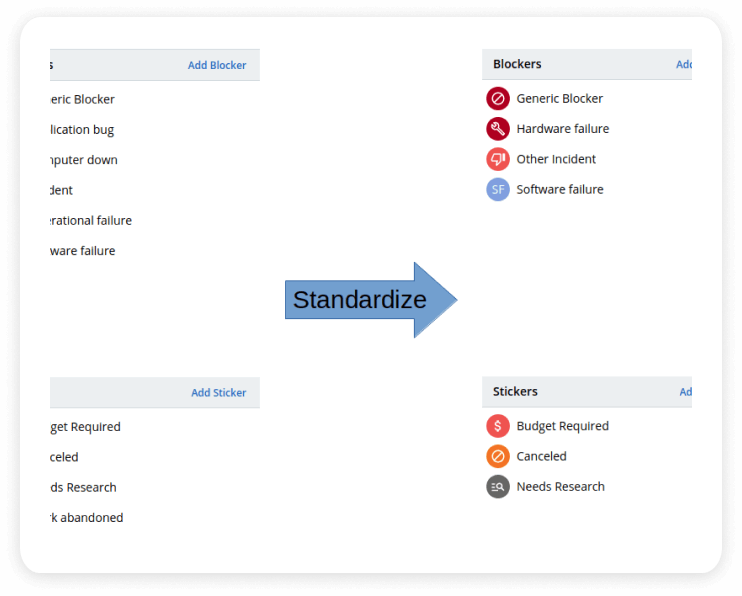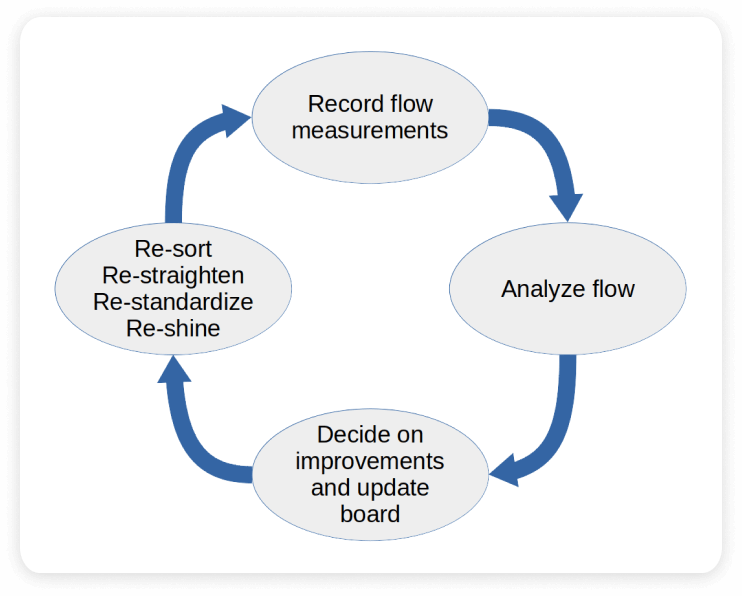When introducing Kanban and a supporting software tool to an organization, there is generally a trial period during which teams start to experience how the tool supports the method. In some cases, teams think of Kanban as little more than a set of columns and lanes in which cards are arrayed. The result is often a board of great complexity, doing little to truly help the team manage the flow of its work.
This "sandbox" approach to experiencing a tool like Businessmap has many benefits. It encourages investigation, experimentation, self-organization, and autonomy. However, at some point, it becomes useful to reduce a somewhat chaotic set of boards and practices to a more useful and manageable situation. This is especially the case when many teams must collaborate closely throughout the value chain. I have found it very helpful to apply Lean management's 5S approach to help achieve this goal.
What Are the 5S?
The 5S is a core component of the Lean management method. In my view, starting to apply the 5S makes for a solid foundation for all other transformation and improvement activities. Originally, the 5S was articulated for managing the workplace in a factory. Given that the practice was first formalized in Japan, Japanese terms are sometimes used, although English pseudo-equivalents have also been defined as follows:
| Japanese term | Japanese meaning | English equivalent | Description |
| Seiri | Organize | Sort | Eliminate from the workplace objects that are not needed to perform the work |
| Seiton | Orderliness | Set in order, straighten | For the objects that remain in the workplace, arrange them in order |
| Seiso | Cleanliness | Shine | Keep the workplace clean |
| Seikutse | Standardize | Standardize | Apply consistent methods |
| Shitsuke | Discipline | Sustain | Perform the practices of the 5 S in a continual way |
The Kanban Board as a Virtual Workplace
Even before we started using software to help manage flow, the physical Kanban board used to manage the flow of knowledge work was already virtualization. The kanban card was no longer a physical card near the bottom of a batch of components, indicating that it was time to replenish the local stock. Instead, the kanban card, although remaining a physical card, came to represent the activity itself. When physical Kanban boards started to be replaced by software boards, the board and its cards came to be an abstraction of an abstraction.
We increasingly constituted de-localized teams. Often we have the team members working from home. And so, the digital Kanban board came to be a virtual workplace - at least, the workplace in which a team would manage the flow of its work. How, then, are we to apply the 5 S to a Kanban board as a virtual workplace?
Seiri - Sort
When a team develops its board through experimentation, often learning the use of the software tool at the same time, it often creates redundant columns or lanes, or structures that turn out to have little use. Team members might have some fun in setting colors or background images, but it turns out they are more of a distraction than a help. The board should be reorganized and such components should be eliminated. Default items that cannot be applied to the team's needs should be repurposed or deleted. I have seen cases where the same information is displayed via two different techniques. In one case, both card color and swimlane color were used to indicate types of work items (ignoring the card type attribute).
One might also consider whether such elements as blocker types, card types, card template types, or sticker types are orthogonal. Often, when types are created on an ad hoc basis, little consideration is given to whether an existing type may be re-used instead of creating a new one. Without any reflection and control, the result may be a long, redundant, and chaotic list of types. Getting the team's agreement on a simpler and shorter list may be helpful.
 Fig. 1: Remove decorations from the board if they do not help to manage flow.
Fig. 1: Remove decorations from the board if they do not help to manage flow.
In the longer term, it is frequently the case that a column, a card type, automation, or any other element no longer serves the purpose for which it was created. Such elements, too, should be deleted if they remain unused or, worse, misused. Be sure to review the board frequently enough and ensure that the team has not completely forgotten why the element was created in the first place.
Seiton - Set in Order, Straighten
Among the elements that remain in the board configuration, it is frequently helpful to reorganize how various objectives are achieved. For example, I have seen cases where users have solved problems with complicated automation, problems that could have been solved more elegantly (and cheaply) via Kanban card templates.
When a team has more complicated work, with multiple workflows at the card or initiative level, consider the order in which workflows and swimlanes are displayed. It is well known that the eye is attracted to different parts of a picture in a certain order. Try to associate that order with the importance of the various components.
I would also consider setting in order what information is visualized. Unless you are working as an individual or in a small team with a highly limited mission, you are likely to have more information available on a board than what you can easily see at a glance.
Of course, project and portfolio management tools such as Businessmap may offer many features to display and hide information. But every time you have to click on a workflow header to see the workflow, every time you have to expand or contract a column, every time you have to scroll the window to see what you want, you are diminishing your capability to visualize the state of work easily. I treat a Kanban board as very expensive and precious real estate, with each corner of it to be used to the best effect.
Consequently, setting in order the board is also a question of reviewing all the visualization settings to ensure that everything visible on the board without additional manipulation serves to make decisions about how to manage the flow of work. If you display data but do not regularly use it, consider whether it might be better to use that display space for something else.
Seiso - Shine
Making your virtual workplace shine - keeping it clean - also has sense in a virtual workplace. For example, what do you do with the cards in the Done zone or, for that matter, or those that should already be archived? Do they serve some purpose in a daily stand-up meeting? Do you even have a daily stand-up meeting? If not, consider cleaning them up quickly rather than cluttering the board.
What about the problem of keeping your cards up to date relative to the true state of work? One customer asked me if it were possible to "fix" a completion date for a card because a user had dragged a card into the Done column a week after it was really done. Do you take a minute to add blocker tokens, or do you just leave the blocked card in place? What about canceled cards or cards that ought to be in a temporary holding area? Are they put in the place where they belong, or is this just considered to be administrative work performed when you have a free moment to do so?
Keeping a virtual workplace clean is largely about maintaining the integrity of the data. Insofar as software tools automatically record data about the history of each work item, that integrity is ensured by keeping the board shiny and clean.
Seiketsu - Standardize
Suppose you have an organization with many teams and their assorted boards. You will likely need to make compromises between leaving teams to be fully autonomous and self-organizing, on the one hand, and the need to have coherent information flowing into the organization's management boards.
For example, several teams might decide to create their own blocker tokens or card types. Those blockers or those types might be very similar, only the names differing. At some point, you should recognize that those objects are semantically the same and should be standardized across the boards or throughout the workspace.
 Fig. 2. Standardize the use of card tokens
Fig. 2. Standardize the use of card tokens
Another form of standardization is the conformity of the use of a software solution according to its intended functionality. You might be able to use a screwdriver to chisel wood or a hammer to sink a screw (instead of a nail), but this is hardly how those tools were intended to be used. Without dampening the spirit of innovation, users might need to be nudged to an understanding that certain uses of a software tool's functions are better aligned to longer-term strategies and general practices than are other uses.
For example, Businessmap features the ability to define a parent-child relation between cards. Users can also define checklists within cards. I have found new users to have difficulty getting their heads around the difference between the parent-child relation and the card-checklist item relation. Thus, I would get questions about how to manage the dependencies among checklist items, even though the tool intends to model such dependencies using the parent-child relation. It can take a lot of gentle nudging to get users to understand the difference.
Many other forms of standardization might be useful. Setting a naming convention for cards, boards, or card templates might enhance the value of visualization and simplify the use of the software tool. Setting policies for the use of the description fields might save a lot of work farther down the line. I recommend that description fields - such as columns, lanes, or board policies - should include information about the particular reasons the object was created or why certain settings have been made. Having that information helps to inform future decisions about whether the object in question should be conserved, modified, or deleted.
Shitsuke - Sustain
The workplace where a team manages the flow of its work is, of necessity, a living, changing place. Thus, all the practices described above need to be part of an organization's continual adaptation to changes in its mission, its competitive position, the needs and expectations of its customers, changes in the constitution of its teams, and those teams' changing capabilities. Teams may wish to sustain their board(s) as part of an existing cadence, such as the Service Delivery Review. Creating a periodic intangible class of service work items to review the 5S may be helpful. Of course, other cadences or ad hoc adjustments are possible, as long as the team understands that the 5S are sustenance for using Kanban and its supporting tools.
 Fig. 3: Include sort, straighten, standardize and shine in the improvement feedback loop.
Fig. 3: Include sort, straighten, standardize and shine in the improvement feedback loop.

Robert Falkowitz
Guest Author
Robert S. Falkowitz is a lean and Kanban trainer and coach. He has worked with a wide range of organizations, from the very large to the quite small, in a variety of sectors, such as pharmaceuticals, finance and banking, manufacturing, and others. In earlier avatars, he has worked in software development, application integration, infrastructure design, and service management.



